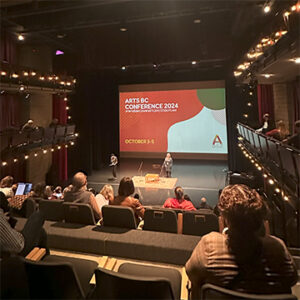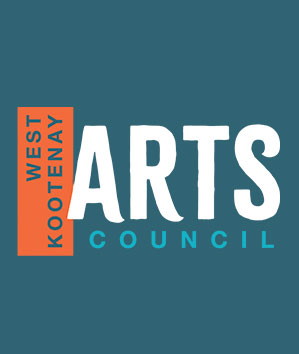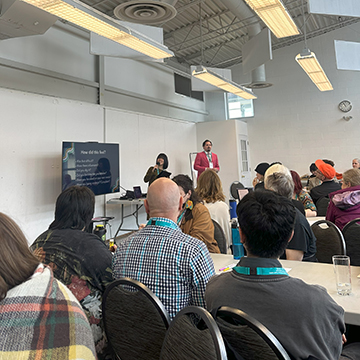JOINING WITH COLLEAGUES TO SHIFT THE NARRATIVE OF ARTS AND CULTURE

From October 3 to 5, 2024, artists and cultural workers from across British Columbia met in kʷikʷəƛ̓əm | Coquitlam for the biannual Arts BC conference. One of the most resonant themes at this year’s event was the need for arts organizations, arts workers, artists and arts supporters to “shift the narrative” around arts and culture’s role in society. Presenters emphasized the significant economic contributions of arts and culture within BC and their critical role in fostering healthy communities and ecosystems. Here are a few standout examples.
Scotia Monkivitch from the Creative Recovery Network gave an inspiring presentation on how her organization uses arts and culture in disaster management and recovery efforts across Australia. Her talk highlighted how the arts can be a powerful tool for communication and healing. In one project she highlighted, artists crafted birdhouses to provide shelter for animals displaced during wildfire, creating a symbol of hope and renewal within the transformed landscape. Similarly, the Chook Project invited communities to knit colourful chickens as comforting gifts for children who had lost their schools and homes to wildfire. These projects go beyond aesthetics, offering accessible and meaningful ways for people to process trauma and loss collectively.

X’staam Hana’ax Nicole Halbauer, Research Manager for H.E.A.L. Healthcare at the Health Arts Research Centre, urged conference attendees to see the arts as an essential counterpart to the sciences. She shared the example of graphic novels being used in training healthcare professionals, particularly in anti-bias training, to deepen empathy and understanding. Halbauer stressed that arts are not merely complementary to sciences but are essential tools for rethinking and enriching healthcare practices.
These examples underscore the essential role of arts and culture in society, reminding us that they are far more than sources of inspiration—they are foundational to resilience, understanding and community well-being.
Additionally, conference sessions called on us, as arts leaders, to create shifts within our organizations. A metaphor that came up several times throughout the conference (thanks to Sidi Chen) is that the arts are not just the icing on a cupcake; they’re the flour, eggs and milk. You can’t have a cupcake without those ingredients, and—as Nicole Halbauer added—you can’t remove them once they’re baked. Equity work should live in a similarly central place within organizations, suffusing every aspect of cultural work.

Confronting outdated narratives in the broader sector sometimes requires us to look inside our organizations and ask honestly, “Are there patterns of harm that our work is perpetuating?” Conference presenters offered meaningful tools to help answer that question. Dagan Nish from ActSafe broke down for session attendees the difference between mental health, psychological safety, and psychological health and safety. While taking each of these seriously can improve the well-being of our teams, Nish also advocated for a shift in how we regard the value of these workplace factors. Amy Edmondson’s research out of Harvard University has demonstrated that psychological safety is the number one factor in workplace productivity; it is high time that supportive and caring workplaces are seen as having a competitive edge.
Meena Das, an expert in non-profit data management and evaluation, guided participants through an exploration of how values and a commitment to equity can be expressed in seemingly simple processes like survey creation. For instance, if “inclusivity” is an organizational value, are you ensuring that everyone who takes your survey can see themselves reflected in the options provided? If you value “accountability,” are you acting on insights the community provides to you, or simply performing an engagement process?
The energy in plenary and breakout sessions was palpable. While changing the narrative around our sector’s value won’t happen overnight, the Arts BC conference was a vital step toward a shared language and the creation of a province-wide commitment to advocating for stronger investment in the arts, for the sake of our sector and our communities at large.
Written by Ingrid Love, Social Media Coordinator of the West Kootenay Regional Arts Council, and Kallee Lins, Executive Director.

